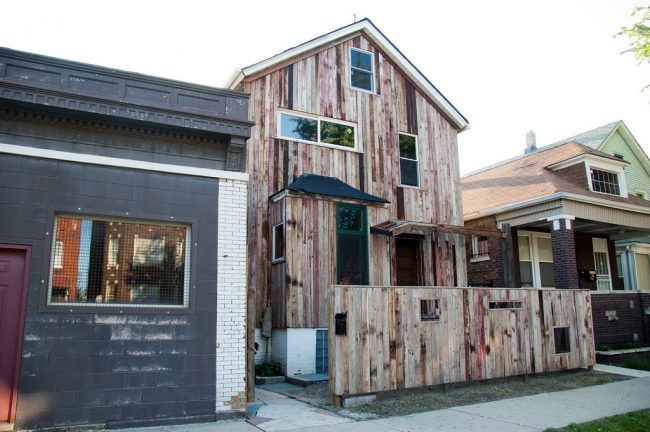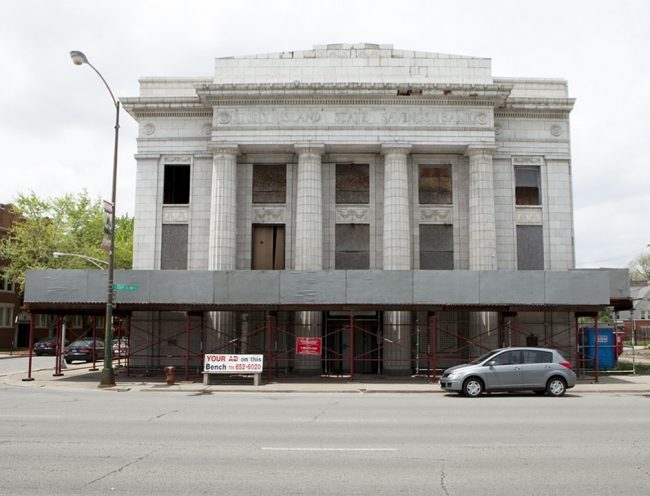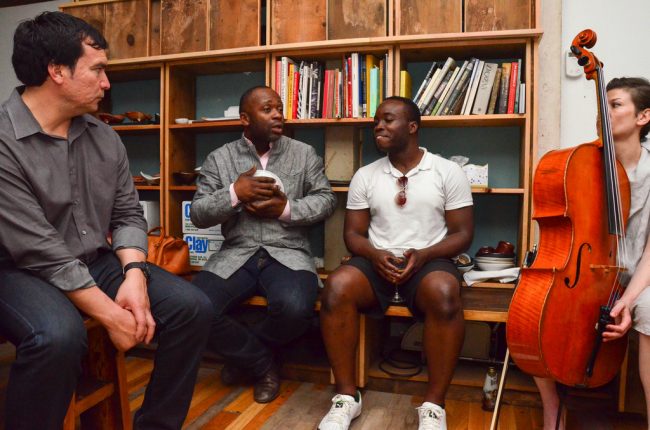
We are celebrating 15 years — and counting — of stories that are deeply researched and deeply felt, that build a historical record of what the city has been.
We are celebrating 15 years — and counting — of stories that are deeply researched and deeply felt, that build a historical record of what the city has been.

One of the renovated houses part of the Dorchester Projects, now housing a glass lantern slide and architectural book archive | Photo via Eric Allix Rogers
Theaster Gates, this year’s Lewis Mumford lecturer on urbanism at City College, presents in a way similar to how his buildings perform: poetically and whimsically. His style of oratory — composed as an organic chain of animated anecdotes — allows his ideas to wash over and engage the audience emotionally without ever being didactic. With captivating and charismatic delivery, he avoids touring the audience through the bricks and mortar, instead prioritizing process over form through storytelling. However unintentional, Theaster Gates and his work have amassed a considerable following, yet his practice defies a single definition. He has become known for transforming dilapidated buildings in underserved communities into hubs of artistic activity, most notably in Chicago’s South Side with the Dorchester Projects, a design/build project for which he renovated nine houses into a cluster of cultural institutions with special collections of local artifacts. Trained in ceramics, religious studies, and urban planning, Gates now combines those and other “habits he enjoys” into his form of what has been termed “social practice”: a marriage of community development, architecture and construction, art installations, performance, and, ultimately, whatever it takes to garner support for change. He carries this out whenever he sees the possibility: the empty pockets within Chicago’s urban landscape. By identifying the latent value in neglected architecture and regenerating these “little buildings,” Gates creates new social possibilities and deepens local cultural connections.
Set before the Edwin H. Blashfield mural in the Great Hall at City College, Director of the Graduate Program in Urban Design Michael Sorkin framed Gates’ talk with the guiding question of the series: “what does it mean to do urbanism?” Social practice is arguably a type of urbanism, one of the multifarious urbanisms now absorbed into the field’s lexicon: tactical urbanism, informal urbanism, ecological urbanism. To this list, Gates adds “liquor store urbanism” and “storefront church urbanism,” two typologies seen on Chicago’s West Side, where the artist was raised. The list of fill-in-the-blank urbanisms goes on, transforming the expanded field into a Mad Libs puzzle. Seemingly in response to Sorkin’s provocation, Gates adopted “queer urbanism” as one way to consider his self-proclaimed “peculiar” way of working. “Queer urbanism” might encompass the set of strategies that are deployed to navigate and redefine site-specific parameters in socially-based art including “our,” “community,” and “place.”

The future Stony Island Arts Bank | Image via TheasterGates.com
Titled “Place Over Time: New Symbols for Durational Encounters with the City,” the talk alluded to placemaking, a practice that has forever been embedded in the subconscious of architects and designers, but has recently branched out as its own field of inquiry in a similar way to the increased specialization within urbanism. Simultaneously acknowledging his participation in this evolving field and humorously deploying it as a trendy catchphrase, Gates suggested that placemaking ultimately exposes the distance between places, rather than simply creating “something” out of “nothing” — those empty or neglected urban frames. As Gates illustrated with his storytelling approach, this distance might be manifested in condensation on a window pane separating a wine-heavy gallery reception from the “others” outside: the people who inhabited the street prior to the place being made and who remain there, excluded from the formulaic social standards of the art world. How then, does placemaking distinguish itself from gentrification? By Gates’ definition, gentrification can be a process in which art is a lever for a local community’s self-transformation. Change from the core is key to his practice, bending art towards community organizing throughout the research, design, and build phases of these architectural projects. Gates has also masqueraded as a “developer,” a role seemingly antithetical to his motivations. But while this moniker makes him uncomfortable, it has served his practice: he used it to catch the attention of Chicago’s Department of Buildings and purchase, for $1 (plus structural renovation costs), the former bank building on the South Side that he will soon transform into the Stony Island Arts Bank.
In 2013, Gates opened the Arts Incubator in Washington Park, a program he developed as Director of Arts + Public Life at the University of Chicago. Expanding the model of the Dorchester Projects, the renovated building is now home to artist residencies, a design apprenticeship program, exhibitions, performances, and talks. In line with this dialogue-based programming, Gates is interested in the communal care of existing architecture, which he explicitly defined in opposition to preservation, what he describes as the monumental stasis of historical objects. Instead, he is a proponent of the critical conservation of objects and places that have demonstrated merit to a given community. Critical conservation expands the sterile grasp of the past expressed through what Gates termed elitist 20th century preservation to include nuanced urban contexts, loosening the grip on historical replication for broader, more interpretive design and development. Showing slides from an archival collection, Gates spoke about reinstating value in the subject within the object, whether a historical image, a building, or a person. In the act of positioning perhaps otherwise forgotten artifacts in a museum context, Gates creates a history and validation for historically excluded communities. “Queer form is what makes us who we are,” Gates says. Textbook taxonomies no longer apply in critical conservation, Mad Libs urbanism, placemaking, or social practice art.

Theaster Gates at the Dorchester Projects | Photo via Eric Allix Rogers
What then is the role of the architect after architecture? Once architects assume agency, they can personally engage in the possibility of transformation. Gates seeks to develop the stable but “invisible structures or platforms that make the things that are truly seen;” the relationships behind the work that made the work possible. These relationships, not the buildings, define his practice, Gates notes. As relationships develop from one-to-one, to one-to-many, to many-to-many, a rhizomatic “community” base begins to form. Difficult to define as a group, “community” for Gates translates to those people and influences that engage in a project, and a place, over time. When this engagement is successful, architecture becomes a service and the spirit of the built environment is maintained or restored. Architecture once again has agency. By the end of his talk, it became clear that the anecdotes that evoked laughter and audible nods from the audience are the spine of Gates’ work rather than appendages. He is actively building community relationships and recalling and extending those through presentation.
A good city, as defined by Sorkin, is collaborative, uncertain, negotiated for empowerment and growth, and, most importantly, it belongs to its citizens. Cultural reinvestment and moral consciousness, as Gates demonstrates, makes room for the cultural “core” of the city as political and economic byproducts shift. Gates charged the audience to pull together minds and resources to actively create change. The next time we pass a building and say to ourselves, “someone should do something with that,” Gates wants each of us to do urbanism.
The views expressed here are those of the authors only and do not reflect the position of The Architectural League of New York.